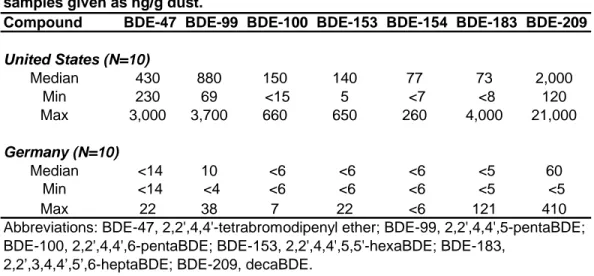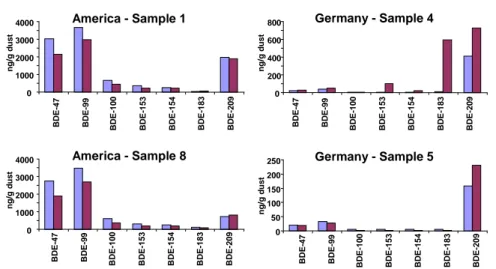Concentration of Polybrominated Diphenyl Ethers (PBDEs)
in House Hold Dust from Various Countries - Inhalation a
Potential Route of Human Exposure
Andreas Sjödin2, Olaf Päpke1, Ernest McGahee III2, Richard Jones2,
Jean-Francois Focant2, Tanja Pless-Mulloli3, Leisa-Maree Toms4, Richard Wang2, Yalin Zhang2, Larry Needham2, Thomas Herrmann1, Donald Patterson Jr.2
1
ERGO Research, Hamburg 2
Centers for Disease Control and Prevention (CDC) Atlanta 3
School of Population and Health Services, Newcastle 4
National Research Centre for Environmental Toxicology, Coopers Plains
Introduction
Polybrominated diphenyl ethers (PBDEs) are congeners of a class of environmental contaminants that have been present in the environment for decades. PBDEs were first identified in the River Viskan in Sweden1 and have since then been recognized as an environmental contaminant with a global distribution as shown by the detection of this compound class in aquatic and terrestrial environments in Europe 2 and North America. 3
Human PBDE levels have been shown to be increasing in Sweden 4, Norway 5 and in the United States. 6 This indicates a wide spread human exposure to this class of chemicals. Technical pentaBDE and octaBDE have been withdrawn from the market in Europe 7 and the single producer of these products in the United States has agreed to phase-out manufacturing of these products by the end of 2004. No restrictions for commercial DecaBDE are planned in the United States.
However, PBDEs will still be present in consumer products sold prior to the phase out of pentaBDE and octaBDE for decades to come. Hence it is of utmost importance to identify the exposure routes to humans especially in the Unites States where much higher levels of PBDEs have been observed in people. An average level of 34 ng/g lipid has been observed in human serum pools collected in 2002 6 and values in the range of 2.9-272 ng lipid (average 41ng/g lipid) have been observed in human milk. 8 This can be contrasted to levels observed in Swedish milk pools
reported in foodstuffs sampled in the United States. 9
Our approach was to use the contents of vacuum cleaner bags as an indication of indoor PBDE contamination. The results from this study have to be followed up by air sampling and biomonitoring studies to answer if PBDE exposure through inhalation of dust and/or dermal contact could be a major exposure route in the United States.
Materials and Methods
Vacuum cleaner bags were collected in Germany (N=10) and in Atlanta, United States (N=10), Australia (N=10) and United Kingdom (N=10). The bags from the 40 different households were opened and the content transferred to a household sieve with a hole size of ~2mm. The sample was sieved by shaking and particulate matter was collected on aluminum foil. After a sufficiently large sample of particulate matter had been collected on the foil, the sample was transferred to a Ziploc® bag and stored at room temperature until analysis. Between each sample the sieve was cleaned and the aluminum foil replaced.
The samples (0.2g) were extracted by transferring the sample to an accelerated solvent extraction® (ASE) cell (11mL) filled with Hydromatrix (Varian Inc; Palo Alto, CA). The samples were extracted using ASE (Dionex; Sunnyvale, CA) employing hexane as the solvent using the following settings: Temperature, 100oC, purge volume 60%, nitrogen purge time 60 seconds, pressure 1500psi, no preheat time and static extraction time 5 minutes and three repeated extraction cycles. The cell and inert content had been cleaned prior to adding the dust sample by extracting the cell using the same parameters as for the sample extraction. Blank samples (N=3) comprised of only Hydromatrix were also included among the unknowns.
Three samples from the United States and three samples from Germany were extracted a second time in order to verify complete extraction.
The collection vial used at the extractor were weighed before and after extraction in order to calculate exact amount of solvent collected, i.e., approximately 30mL. Concentrated sulfuric acid (5mL) was added to the dust samples and the samples subsequently rocked for 5 minutes. A small aliquot was drawn from each sample (100µL) and added to GC-vials containing 13C-labeled triBDE to decaBDE internal surrogate standards (750pg/congener). The samples were evaporated to 10µL and analyzed by gas chromatography high-resolution mass spectrometry (GC/HR-MS) on a MAT95 (ThermoFinnigan MAT, Bremen, Germany). The level of PBDEs in the samples was calculated as ng/g dust taking into account the dilution step.
Results
At the time of preparation this abstracts only the data for dust samples from Germany and the United States were available. In the following we will concentrate on these samples.
The sum PBDE concentration in dust samples collected in Germany, mainly Northern Germany, ranged from 17-550 ng/g dust (median 74) while a concentration range of 530-29,000 ng/g dust (median 4,200) was found in the samples collected in the United States. 2,2’,4,4’-TetraBDE (BDE-47) and decaBDE (BDE-209) were the most abundant PBDE congeners recovered. The pentaBDE pattern observed in the dust samples was similar to that found in the technical products, i.e. 2,2’,4,4’,5-pentaBDE (BDE-99) is similar in concentration to that of BDE-47 (Table 1 and Figure 1). The observed difference in concentration between Germany and the United States was statistically significant (U-Test).
Table 1. Concentration of polybrominated diphenyl ethers (PBDEs) in dust samples given as ng/g dust.
Compound BDE-47 BDE-99 BDE-100 BDE-153 BDE-154 BDE-183 BDE-209
United States (N=10) Median 430 880 150 140 77 73 2,000 Min 230 69 <15 5 <7 <8 120 Max 3,000 3,700 660 650 260 4,000 21,000 Germany (N=10) Median <14 10 <6 <6 <6 <5 60 Min <14 <4 <6 <6 <6 <5 <5 Max 22 38 7 22 <6 121 410
Abbreviations: BDE-47, 2,2',4,4'-tetrabromodipenyl ether; BDE-99, 2,2',4,4',5-pentaBDE; BDE-100, 2,2',4,4',6-pentaBDE; BDE-153, 2,2',4,4',5,5'-hexaBDE; BDE-183,
2,2’,3,4,4’,5’,6-heptaBDE; BDE-209, decaBDE.
For the six samples that were extracted twice, PBDEs in the second extract were found at levels below the quantification limit defined as 3 times the standard deviation of blank samples or at levels below the instrumental detection limit. Verification analyses showed a good agreement in-between the two labs in most cases (Figure 2). Although, some differences was noted that may be related to sample inhomogenisity
Swedish and Latvian fishermen consuming large quantities of fish caught in the Baltic Sea. 11 Considering the intake of an adult of between 10 to 100 mg of dust (dust contains e.g. 4000 ng/g PBDEs) we may expect an intake via dust of up to 400 ng per day per person. This intake may add to the intake via food of between 50 and 100 ng per day per person as reported by various authors. 12,13
We can not conclude what exposure routes are more important to humans in the United States and Germany, but we can conclude that in indoor dust the levels of PBDEs are much higher in the United States than in Germany (Table 1 and Figure 1). In light of these finding and the fact that higher levels are reported in people living in the United States 14 this potentially important route of exposure has to be studied in-depth in the future.
0 500 1000 1500 2000 2500 3000 3500 BDE -4 7 BDE -9 9 BDE -1 0 0 BDE -1 5 3 BDE -1 5 4 BDE -1 8 3 BDE -2 0 9 ng/ g D u s t
United States
Germany
Figure 1. Concentration of polybrominated diphenyl ethers in dust
samples from Germany and the United States. Error bars indicates quartile range.
CDC Measurement ERGO Measurement America - Sample 1 0 1000 2000 3000 4000 BDE -4 7 BDE -9 9 BDE -100 BDE -153 BDE -154 BDE -183 BDE -209 n g /g d u s t America - Sample 8 0 1000 2000 3000 4000 BDE -47 BDE -99 BD E-1 0 0 BD E-1 5 3 BD E-1 5 4 BD E-1 8 3 BD E-2 0 9 ng /g d u st Germany - Sample 4 0 200 400 600 800 BDE -4 7 BDE -9 9 BDE -100 BDE -153 BDE -154 BDE -183 BDE -209 n g /g d u s t Germany - Sample 5 0 50 100 150 200 250 BD E -47 BD E -99 BDE -100 BDE -15 3 BDE -15 4 BDE -18 3 BDE -20 9 ng/g d u s t
Figure 2. Quality control by parallel analysis of PBDEs in house dust by
two different laboratories (CDC respectively ERGO research).
References
(1) Andersson, Ö. and Blomkvist, G.,. Chemosphere, 1981, 10, 1051-1060.
(2) Asplund, L., Athanasiadou, M., Sjödin, A., Bergman, Å. and Börjeson, H.,. Ambio, 1999, 28, 67-76.
(3) Norstrom, R. J., Simon, M., Moisey, J., Wakeford, B. and Weseloh, D. V. C.,. Environ Sci
Technol, 2002, 36, 4783-4789.
(4) Meironyté, D., Norén, K. and Bergman, Å.,. J Toxicol Environ Health, 1999, 58 Part A, 329-341.
(5) Thomsen, C., Lundanes, E. and Becher, G.,. Environ Sci Technol, 2002, 36, 1414-1418. (6) Sjödin A., Jones R. S., Focant J.-F., Lapeza C. R., Wang R. Y., McGahee E. E. I., Zhang Y,
Turner W. E., Slazyk B., Needham L. L., and Patterson Jr D. G. Environmental Health
Perspectives, In press.
(7) Cox, P. and Efthymiou, P.,. Official Journal of the European Union, 2003, OJ L 42, 45-46. (8) Schecter, A., Pavuk, M., Päpke, O., Ryan, J. J., Birnbaum, L. and Rosen, R.,. Environ Health
Food Chem, 2003, 51, 3191-3195.
(13) Ryan, J. J. and Patry, B.,. Organohalogen Comp, 2001, 51, 226-229.


